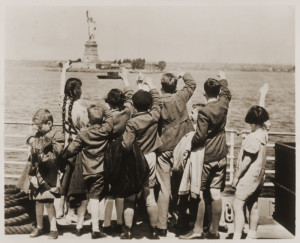“Give me your tired, your poor, Your huddled masses yearning to breathe free, The wretched refuse of your teeming shore. Send these, the homeless, tempest-tossed to me, I lift my lamp beside the golden door!”

Jewish refugee children wave at the Statue of Liberty as the President Harding steams into New York Harbor, 1939. United States Holocaust Memorial Museum
Written on the base of the Statue of Liberty, this quote reflects one of the most fundamental of American values: openness to those yearning to be free from the chains that bind them.
With 21.3 million refugees worldwide, the highest number since the 1940s, it is essential that the United States recommit to these ideals by welcoming refugees of all religions and nationalities. Today, on Holocaust Remembrance Day, President Trump is readying himself to sign an Executive Order to halt refugee resettlement and ban visas for people from Muslim-majority countries including Syria, Iraq, Iran, Sudan, Libya, Somalia, and Yemen – effectively a ban on Muslims.

Infographic from the White House archives.
Widespread fear of refugees is grounded in prejudice and ignorance. Refugees undergo the most heavily-scrutinized screening process of any group allowed entry into the US. Unlike European nations, in order to protect the American people from any serious security threat, the United States screens all refugees for 18-24 months before they even set foot on US soil. As of September 2015, 23,092 Syrian refugees were referred to the US Refugees Admission Program, with 7,014 interviewed by the Department of Homeland Security since 2011, and 2,034 admitted to the United States. Zero Syrian refugees resettled in the United States have been arrested or removed on terrorism charges.
While the refugee resettlement program can never be completely risk-free, there is a thorough 9-step vetting process already in place that ensures refugees are as low risk as possible before they are admitted.
In the United States, we embrace diversity, whether it be diversity of religion, race, nationality, culture, or identity. We value that which makes us different because we know that our differences make us stronger.
Throughout history, refugees have made significant contributions to American history and culture. In fact, Madeleine Albright, the first female US Secretary of State, came to the United States as a refugee when she was 11. Former Secretary of State Henry Kissinger came to the United States as a refugee in 1938, fleeing Nazi persecution. Albert Einstein, the author of the theory of relativity, as well as countless other findings and inventions, came to the United States as a refugee in 1933.
The acceptance of refugees in the past has not only helped shape America into the country it is today, it has also shaped my life in profound ways. I am descended from two families of refugees, both coming to this continent in different times but for strikingly similar reasons.
My dad’s family came to the United States on the Mayflower. The Puritans came to the United States in search of a place where they could practice their religion and their belief system without threats from surrounding communities. They wanted a better life for their children, and their children’s children–and if you multiply that process about 17 times, they came to this new land so that I could live the life I’m living today.
My mom’s family came to the United States much more recently. My family came to the United States preceding the Holocaust to escape the pogroms that swept across Europe in the early 1900s. My grandma’s family was resettled into the Lower East Side of New York City by HIAS, one of the major refugee resettlement organizations that still operates today. Now, I too live on the Lower East Side, just blocks from where my family resettled generations ago.
Perhaps most striking, though, is the part of my family that came desperately to the United States as refugees and were turned away, forced to return to Europe and, ultimately, to be killed. When my family arrived in Boston, it was discovered that my great, great aunt Rachel had tuberculosis, and she was forbidden from entering the country. Officials forced her to return to her home in Eastern Europe. While in the hospital after her return, Rachel wrote letters to my family regularly. But one day, the letters stopped coming, and they never heard from her again. It was later discovered that around the same time the Nazis had invaded the town where my great, great aunt Rachel lived. We can only assume that she was taken by the Nazis and killed in a concentration camp. Her name is not in Yad Vashem’s Shoah Victims’ Names Database, and we do not know where she lived her last days or where she died. She only lives on in our memories.
My great, great aunt Rachel represents a whole slice of the world that will never exist. She could have had children, made great discoveries, or devoted herself to improving her community. But instead she was turned away, and the unrealized potential of a precious human life was lost.
The United States has made significant mistakes in the past, but we must always strive to be a stronger, more welcoming, and more loving nation. We must support those who need it most, and in doing so, we will allow our country to flourish and grow in new ways—ways that will truly make America great.
–
 Francesca Freeman is a STAND alumna, and served as STAND’s National Student Director for the 2015-2016 school year. Francesca holds a B.A. from the University of Chicago, and is a Program Assistant at the Social Science Research Council. You can follow Francesca on twitter at @francescafree16.
Francesca Freeman is a STAND alumna, and served as STAND’s National Student Director for the 2015-2016 school year. Francesca holds a B.A. from the University of Chicago, and is a Program Assistant at the Social Science Research Council. You can follow Francesca on twitter at @francescafree16.

Pingback: #AmericaDoesNotBan: Refugees in the US Yesterday and Today - STAND CANADA